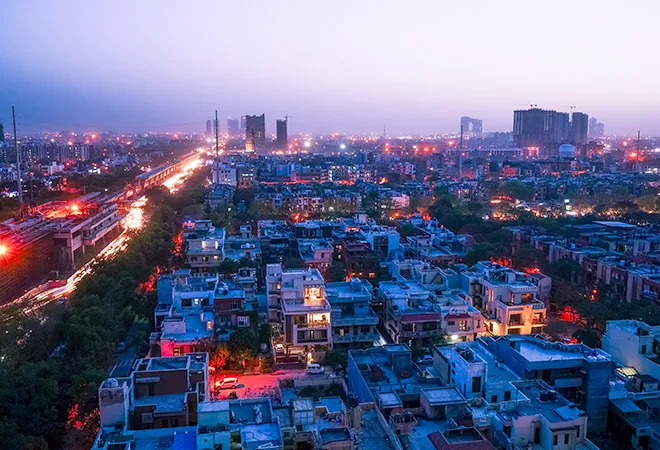
A number of Indian states have created urban parastatals in the field of regional urban development comprising large geographies beyond the limits of urban local bodies. This follows the universally-accepted concept that urbanisation does not stop at the physical boundaries of a city. Developments take place outside as rural hinterlands turn more and more urban. It, consequently, makes sense that such urbanisation is guided by an agency that is in charge of regional development that a city cannot control by virtue of the area being outside its physical jurisdiction. These parastatals draw up their own regional plans and development control regulations for the synchronised and progressive urbanisation of the entire area.
It...makes sense that such urbanisation is guided by an agency that is in charge of regional development that a city cannot control by virtue of the area being outside its physical jurisdiction.
For instance, the city of Bengaluru has a physical area of about 741 sq. km. However, the Bangalore Development Authority (BDA) covers an area of 1,207 sq. km. and a further urban layer is provided by the Bangalore Metropolitan Region Development Authority (BMRDA) spread over more than 8,000 sq km. Similarly, the city of Hyderabad with an area of 650 sq km is circumscribed by the Hyderabad Metropolitan Development Authority with an area of 7,257 sq. km. Greater Mumbai that has a total area of 476 sq. km. However, the Mumbai Metropolitan Region covers an area over 4,335 sq. km. comprising of eight municipal corporations, nine municipal councils and several other towns and villages.
While the essential function of these parastatals lies in the area of regional planning, most of them, with the passage of time, have crossed into the territory of infrastructure provision. This primarily comprises of roads, flyovers, metro rail, airports and other such facilities with the objective of supporting the efforts of the local bodies. Since these infrastructures are capital intensive, regional development authorities have been given large land banks, gifted by the state, generally free of cost, alongside powers to acquire large chunks of private lands. Over time, some have extended their domain replicating the role of private builders. They have built housing, shopping complexes and offices and offloaded them in the market with profit. These activities have transformed these parastatals into large, powerful organisations that are both planning authorities as well as developers.
While the essential function of these parastatals lies in the area of regional planning, most of them, with the passage of time, have crossed into the territory of infrastructure provision.
However, real estate development has its own risks. Some days ago, newspapers reported that the Bangalore Development Authority (BDA) had moved a proposal to its state government seeking permission to enter into a Public-Private Partnership (PPP) with private companies and realtors. The objective was to allow the development of land held by the parastatal by a private company. The private developer will undertake construction and sale of real estate. In return for land, part of constructed properties will be handed over to the parastatals, which, it would then offload in the market to raise resources for building city infrastructure. It has been forced to adopt the PPP model due to the constraint in the availability of capital to undertake infrastructure development. It landed in this situation since it had earlier taken up housing projects and was unable to sell its inventory. It was reported that the parastatal had over 2,000 flats and 30 villas that remained unsold for quite some time.
While it is expected that urban development authorities will deal in land and use its planning powers and land bank to raise resources, turning into a developer appears to be an unwise move. Bound by processes and regulations of a public organisation that it cannot set aside, the parastatals refrain from having the flexibility of process or of pricing or the specialised skill and capacity to negotiate the market. It is not difficult to anticipate that a parastatal-turned-developer is most likely to land into serious financial trouble.
While it is expected that urban development authorities will deal in land and use its planning powers and land bank to raise resources, turning into a developer appears to be an unwise move.
Land and land-based instruments are the best part of tools that a parastatal has for attracting resources, especially since it itself is the planning authority. The High-Powered Expert Committee (HPEC) 2011 categorised these instruments into monetary exactions, land exactions and monetisation of underutilised public land assets. Large cities, where land has gained in value substantially, can use mechanisms like Floor Space Index (FSI) and Transfer of Development Rights (TDR) to raise resources. With respect to FSI, it is recommended that the regulations could specify a minimum and maximum FSI zone-wise and use-wise. A certain minimum FSI may normally be allowed without payment of premium. Any excess FSI wanted could be purchased at an escalating premium from the FSI bank created by the municipal body. Evidently, there would have to be a cap on such use of FSI bearing in mind the ability of the city to assimilate additional construction and provide for city infrastructure, as well as the prescribed maximum built and human density per sq. km.
Land and land-based instruments are the best part of tools that a parastatal has for attracting resources, especially since it itself is the planning authority.
Accommodation Reservation is a further concept that is now in vogue in some Indian cities. This is a land instrument enabling a Planning Authority to acquire part of the reserved land without cash compensation. Through this arrangement, an owner is allowed to use the full construction potential of his land, as per prevailing FSI, on a portion of that land – by and large half – if he surrenders the other half to the local body for public use. This can be further incentivised by allowing a larger FSI to the owner than the normal to enthuse him to accept the concept.
Accommodation Reservation is a further concept that is now in vogue in some Indian cities. This is a land instrument enabling a Planning Authority to acquire part of the reserved land without cash compensation.
On the other hand, it may allow him to utilize the construction potential of his acquired land on some other plot. However, if he does not own an alternate plot, or does not wish to use it himself, he could sell the TDR, just like shares, to anyone who wishes to use it. Since the value of urban land is in its construction potential, TDR is an attractive alternative for city landowners. The use of TDR is a good tool not merely for land acquisition, but also for getting public works executed against the grant of TDR through a calculation of costs of works, and the market rate of TDR. This could be made more attractive with an incentive component added to be given to the owner.
The use of TDR is a good tool not merely for land acquisition, but also for getting public works executed against the grant of TDR through a calculation of costs of works, and the market rate of TDR.
Since land is a finite commodity and since ULBs would have a limited pool of land, the strategy has to be to make use of land in a manner in which a long-lasting income source is created. Hence, permanent land disposal for one-time income is not recommended. There are several examples of smart usage of land by urban bodies. The New Delhi Municipal Corporation leased a land parcel for a hotel. But quite smartly, it neither built the hotel nor sold off the land. It leased it out for a long-term for a handsome fee, leaving the private entrepreneur to build, operate and maintain the hotel. At the end of the lease period, it re-bid the property for a further period of lease for a further fee. It thereby earned revenue year after year without divestiture of land and without investing in construction.
Since land is a finite commodity and since ULBs would have a limited pool of land, the strategy has to be to make use of land in a manner in which a long-lasting income source is created.
With such powerful tools in the hands of city development authorities, it does not make sense for them to get into the highly volatile real estate market, with none of the capacities that market requires. In this regard, the stand of Noida and Greater Noida Authorities, reported in the media, was far sager. Reacting to a proposal by the Supreme Court to take over incomplete housing projects of Amrapali, a real estate developer, the Authorities stated, “We are not technically competent and we do not have expertise in constructing buildings”.
The abiding idea is that the external environment at all times is replete with new opportunities for business entities to seize them. However, to public organisations – especially urban development authorities, they become opportunities only if they fit the objectives of that organisation. The rest are simply distracting temptations. Organisations that fall for them would almost always come to grief.
The views expressed above belong to the author(s). ORF research and analyses now available on Telegram! Click here to access our curated content — blogs, longforms and interviews.




 PREV
PREV


